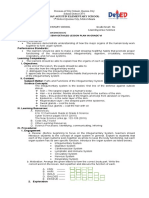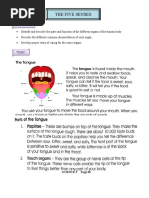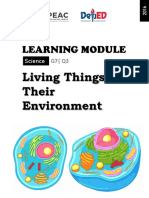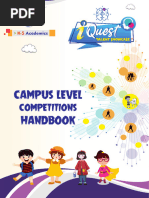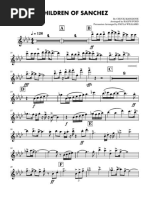Grade 1-2 Basic Animal Parts-Sense Organs
Grade 1-2 Basic Animal Parts-Sense Organs
Uploaded by
Teacher JanaCopyright:
Available Formats
Grade 1-2 Basic Animal Parts-Sense Organs
Grade 1-2 Basic Animal Parts-Sense Organs
Uploaded by
Teacher JanaCopyright
Available Formats
Share this document
Did you find this document useful?
Is this content inappropriate?
Copyright:
Available Formats
Grade 1-2 Basic Animal Parts-Sense Organs
Grade 1-2 Basic Animal Parts-Sense Organs
Uploaded by
Teacher JanaCopyright:
Available Formats
AMSLI BIOLOGY 2021GRADE 1-2
Name:__________________________________
School:_________________________________
MODULE III: BIOLOGY GRADE 1-2
BASIC ANIMAL SENSE PARTS/ORGANS
Prepared by: Adelyn SA. Escobar
Edited by: John Paul B. Arcilla
I. GENERAL DISCUSSION
Animal bodies are similar to a well-designed machine in function and form. These bodies have
many components and elements that work interdependent of each other. In humans, the systems, organs,
tissues, and cells in our body work as a unit and like a machine, it needs protection, and proper maintenance.
Human beings are one of the most complicated organisms on this planet. However, like other
animals, we are also just composed of cells structured into tissues, tissues structured into organs, and organs
structured into organ systems. Without these systems, life wouldn't be possible – we will fail to breathe,
our hearts will stop and we cannot move. Knowledge of how they keep us alive is important.
The major biological systems in our body are in charge of digestion, blood circulation, sense, and
excretion among all others. However, these systems are not just for survival, but also allow us to “fully
live.” These organ systems allow us to hear music, smell the flowers, see colors, form memories, feel pain,
dance and learn. The design of our bodies is really brilliant. Knowing all the systems and their structures
and functions can facilitate us to perceive that our bodies are sacred and deserves to be taken care of.
For more understanding about the topics, refer to following links:
A. BASIC ANIMAL PARTS
Video Lectures:
- Parts of the body: https://www.youtube.com/watch?v=jd3bWUAa9qM
- Human eye: https://www.youtube.com/watch?v=axpCN6Vj9p0
- Skin: https://www.youtube.com/watch?v=yCWclrhsPQ8
- Nose: https://www.youtube.com/watch?v=V9CpmgTPhu8
- Tongue: https://www.youtube.com/watch?v=9uQSfOEFvgA
- Ears: https://www.youtube.com/watch?v=mptjEoHF2aI
B. ADAPTATION
Video Lectures:
- Adaptation: https://www.youtube.com/watch?v=xDSFlRunlrU
AMSLI Biology G1-2 Animal Sense Parts/Organs - Page 1 of 4
AMSLI BIOLOGY 2021GRADE 1-2
II. DEFINITION OF TERMS
1. Organ system - is a group of tissues that perform similar functions
2. Animal- refers to any of the eukaryotic multicellular organisms of the biological kingdom
Animalia generally characterized to be heterotrophic, motile, having specialized sensory organs,
lacking cell wall, and growing from a blastula during embryonic development.
3. Sense organs- the organs of special sense, including the eye, ear, olfactory organ, taste organs,
and the accessory structures associated with these organs.
4. Adaptation- the adjustment or changes in behavior, physiology, and structure of an organism to
become more suited to an environment; the state reached by the biological population undergoing
adjustments or changes
III. ACTIVITY
For the experiment refer to this video: https://www.youtube.com/watch?v=_DQGAcqhkGs
Answer the following questions about the experiment:
1. What are “blubbers”?
2. How does “blubber” help animals that naturally live in cold environment?
3. Cite another example of physical/behavioral adaptations exhibited in a plant or an animal.
AMSLI Biology G1-2 Animal Sense Parts/Organs - Page 2 of 4
AMSLI BIOLOGY 2021GRADE 1-2
Name:__________________________________
School:_________________________________
AMSLI’s SCIENCE ENHANCEMENT PROGRAM
ASSESSMENT 3: BIOLOGY G1-2
BASIC ANIMAL SENSE PARTS/ORGANS
General Direction: This is a 5- - item test, read and follow each directions written in every type of
test.
TRUE OR FALSE
Directions: Write T if the statement is TRUE and F if the statement is FALSE. Write the letter of
your answer on the blank provided at the right side of the test paper.
_____ 1. In hearing, the eardrums acts as a funnel for sounds which is then sent into the ear canal. (pinna)
_____ 2. The iris is a thin oblong structure in the eye that adjusts the amount of light that enters the eye.
(circular)
_____ 3. An organ is the part that carries out a particular function.
_____ 4. The lens converts the light that passes through the eye into electronic signals into an image
perceive in the brain. (retina)
_____ 5. The cells on the very outer layer of the epidermis are constantly dying and getting replaced by
new cells every 4 weeks.
_____ 6. The pupil is the clear front surface of the eye. (cornea)
_____ 7. The hyperdermis’ function is to store fat. (hypodermis)
_____ 8. The skin is the largest organ of the body.
_____ 9. The three bones that the eardrums shake are the smallest bone in the human body. (stapes)
_____ 10. The papillae contains the taste buds.
MULTIPLE CHOICE TEST
Directions: Choose the letter of the correct answer and write it on the blank provided at the right
side of the test paper.
_____ 1. Which of the following is not a part of the middle ear?
a. Pinna c. Eardrum
b. Hammer d. Stapes
_____ 2. What part of the human eye acts as the lens that allows the light in?
a. Pupil c. Iris
b. Cornea d. Lens
_____ 3. What part of the human eye controls the contraction of the pupil?
a. Pupil c. Iris
b. Cornea d. Lens
_____ 5. What do you call content of the skin also adds to the protection from harmful sunrays?
AMSLI Biology G1-2 Animal Sense Parts/Organs - Page 3 of 4
AMSLI BIOLOGY 2021GRADE 1-2
a. Vitamin D c. Melanin
b. Sebum d. Hair
_____6. What is this part of the human body that serves as the outermost layer and protection against the
outside environment?
a. Nails c. Hair
b. Sebum d. Skin
______ 7. What do you call the first layer of skin?
a. Epidermis c. Hypodermis
b. Dermis d. Hyperdermis
______ 8. What do you call the rough bumpy structures on the surface of the tongue?
a. Taste buds c. Papillae
b. Buds d. Salivary gland
ODD ONE OUT
Directions: Choose the word that doesn’t belong to the group then fill in the adjacent box the term
that unified the group.
Doesn’t belong to Unifying Term
the group
9 – 10. Epidermis, Dermis, Hyperdermis,
Hypodermis
11 – 12. Connective tissue, Melanin, Hair
follicles, Sweat glands
13 – 14. Cochlea, Stapes, Ossicle, Hammer
15 – 16. Eardrums, Pinna, Lobule, Helix
17 – 20. Choose a specific sensory organ and list down 4 of its parts (you can add descriptions for each of
the parts as bonus points)
BONUS. Give an example(s) of an animal that adapted to its environment through changing a
certain characteristics or behavior and explain. (maximum of 5 examples) (2 points each)
AMSLI Biology G1-2 Animal Sense Parts/Organs - Page 4 of 4
You might also like
- Scie3 - q2 - Mod1 - Human Sense Organs - V4Document22 pagesScie3 - q2 - Mod1 - Human Sense Organs - V4Reiahne Tyler Osorio100% (9)
- Science 4 Q2 Mod3 Body Structures of Animals v2Document23 pagesScience 4 Q2 Mod3 Body Structures of Animals v2Xyrine Angela San Lorenzo100% (1)
- Plant and Animal ReproductionDocument7 pagesPlant and Animal Reproductionhellohelloworld100% (3)
- Independent 2 15 19 TasksDocument5 pagesIndependent 2 15 19 Tasksapi-372548146No ratings yet
- DLP SCIENCE 6 Q2 WK 1 Day 4Document8 pagesDLP SCIENCE 6 Q2 WK 1 Day 4Roselle Joy EgeraNo ratings yet
- Packet Anatomy Week 1Document10 pagesPacket Anatomy Week 1IRAH RAINELLE ENRIQUEZNo ratings yet
- Q 0h7jscpou, 2s6nvoDocument14 pagesQ 0h7jscpou, 2s6nvoJosh SalengNo ratings yet
- Science3 q2 Mod1 HumanSenseOrgans v2-3Document23 pagesScience3 q2 Mod1 HumanSenseOrgans v2-3Balubal JericoNo ratings yet
- LAS_G7_Science_Q2_W3_V3Document18 pagesLAS_G7_Science_Q2_W3_V3dayostheresaNo ratings yet
- School: San Agustin Elementary School Grade Level: Six Teacher: Jonalvin A. Ke Learning Area: Science Date: SEPTEMBER 5, 2018 (WEDNESDAY)Document3 pagesSchool: San Agustin Elementary School Grade Level: Six Teacher: Jonalvin A. Ke Learning Area: Science Date: SEPTEMBER 5, 2018 (WEDNESDAY)Jonalvin KENo ratings yet
- SCIENCE Grade 7: Quarter 2 - Module 3 Cell To BiosphereDocument12 pagesSCIENCE Grade 7: Quarter 2 - Module 3 Cell To BiosphereMarie Pearl F. Adamos100% (1)
- Q2 G6 Science M1Document21 pagesQ2 G6 Science M1JM MedinaNo ratings yet
- Learning Plan in Science 7: Supang National High SchoolDocument3 pagesLearning Plan in Science 7: Supang National High SchoolEden Mae SabaresNo ratings yet
- Lesson Exemplar in SCIENCE 6 Quarter 2 CALANGINDocument7 pagesLesson Exemplar in SCIENCE 6 Quarter 2 CALANGINCALANGIN, MELANIE C.100% (1)
- FINAL-SSES S6 Q1 2 Endocrine-SystemDocument39 pagesFINAL-SSES S6 Q1 2 Endocrine-SystemMarckFloyd ClutarioNo ratings yet
- Lesson 2 Science 3 Five Senses CONTINUATIONDocument8 pagesLesson 2 Science 3 Five Senses CONTINUATIONErving Nuñez0% (1)
- Learning Module: Living Things and Their EnvironmentDocument139 pagesLearning Module: Living Things and Their EnvironmentDennisNo ratings yet
- Q2 Module 1Document24 pagesQ2 Module 1klokil byeNo ratings yet
- Animals Found at Home and in The CommunityDocument57 pagesAnimals Found at Home and in The CommunityRiza Ara RodriguezNo ratings yet
- Integumentary SystemDocument6 pagesIntegumentary SystemNhecel PascuaNo ratings yet
- SCIENCE 6 Q2 WEEK 1-2Document12 pagesSCIENCE 6 Q2 WEEK 1-2Katherine G. RecareNo ratings yet
- Grade 3 Science Q2 DLP Joe G. MartinezDocument7 pagesGrade 3 Science Q2 DLP Joe G. Martinezjoe martinezNo ratings yet
- Third Term ss3 BiologyDocument28 pagesThird Term ss3 BiologyayandeleadekemiNo ratings yet
- English For Medicine 1Document52 pagesEnglish For Medicine 1hnanguyen100% (19)
- Grade-7-SLM-Q2-Module-2-Levels-of-Biological-Organization-2nd-EdDocument12 pagesGrade-7-SLM-Q2-Module-2-Levels-of-Biological-Organization-2nd-EdroseNo ratings yet
- Assignment No. 7 The Integuments and Its DerivativesDocument2 pagesAssignment No. 7 The Integuments and Its Derivativesj69991842No ratings yet
- Senior Earth Life Science - Q2 - M5 For PrintingDocument28 pagesSenior Earth Life Science - Q2 - M5 For PrintingDeverly ArceoNo ratings yet
- Laboratory Exercise 3 WorksheetDocument5 pagesLaboratory Exercise 3 WorksheetRaiden ShogunNo ratings yet
- EARTHLIFE SCIENCE Q2 WEEK 2 EditedDocument17 pagesEARTHLIFE SCIENCE Q2 WEEK 2 EditedKingsy Gaming ML and LOLNo ratings yet
- Sci7 Q2 Wk3 Module3Document11 pagesSci7 Q2 Wk3 Module3Lester Noel RosalesNo ratings yet
- "Wanted: Dead or Alive?": Department of EducationDocument16 pages"Wanted: Dead or Alive?": Department of EducationJonathan YambaoNo ratings yet
- Module in Earth and Life Science: A. ObjectivesDocument20 pagesModule in Earth and Life Science: A. ObjectivesJay Kenneth BaldoNo ratings yet
- Science-6-Q2-W2Document133 pagesScience-6-Q2-W2rm perdiguerraNo ratings yet
- Iblk Cellsf (Complete)Document10 pagesIblk Cellsf (Complete)Abzde GachoNo ratings yet
- DLL - MathDocument5 pagesDLL - MathElma LacambraNo ratings yet
- Biology Laboratory Manual Series General Zoology Laboratory ManualDocument18 pagesBiology Laboratory Manual Series General Zoology Laboratory ManualAnnaNo ratings yet
- How Do The Parts of The Integumentary System Work?: LessonDocument4 pagesHow Do The Parts of The Integumentary System Work?: LessonSyrill EsperoNo ratings yet
- ELS Q2 M6 Organ Systems of Representative Animals 1 RDocument22 pagesELS Q2 M6 Organ Systems of Representative Animals 1 RtjeremyalleneNo ratings yet
- ELS Q2 Mod 5-6-2023 ActivitiesDocument3 pagesELS Q2 Mod 5-6-2023 Activitiesjosephcinense26No ratings yet
- Science4 q2 Mod4 Specializedstructures v2-1Document23 pagesScience4 q2 Mod4 Specializedstructures v2-1edisongalvan28No ratings yet
- Antagan 2Nd Elementary School: (S6MT-ll-f-3)Document3 pagesAntagan 2Nd Elementary School: (S6MT-ll-f-3)Ethelinda Gambol100% (1)
- Summative Test Science 6 Q2Document5 pagesSummative Test Science 6 Q2Isil Albina100% (2)
- Earth and Life Science - Q2 - Mod13 - Characteristics of Organ Systems - Version1Document28 pagesEarth and Life Science - Q2 - Mod13 - Characteristics of Organ Systems - Version1Glenda Astodillo100% (1)
- Science7 Q2 Module 3Document12 pagesScience7 Q2 Module 3ABIGAIL BATALLERNo ratings yet
- Sci7 Q2 M3 EditedaftercontentlayoutlanguageevaluationDocument23 pagesSci7 Q2 M3 EditedaftercontentlayoutlanguageevaluationNena TabayayNo ratings yet
- Q1W2-WS2Document2 pagesQ1W2-WS2Tabayoyong, Joshua V.No ratings yet
- GENBIO1 - Q1 - MOD4 OF 8 Understanding The Basic Unit of Life.Document22 pagesGENBIO1 - Q1 - MOD4 OF 8 Understanding The Basic Unit of Life.altheacasi2007No ratings yet
- Lesson Plan in Science 7 2 Quarter Date: March 1, 2021: I. ObjectivesDocument3 pagesLesson Plan in Science 7 2 Quarter Date: March 1, 2021: I. ObjectivesJelly Flores100% (1)
- Levels of Biological Organization VideoDocument6 pagesLevels of Biological Organization Videomaximilialo.lopez.gomezNo ratings yet
- Science 7 Module Week 2Document7 pagesScience 7 Module Week 2Jeannie TainoNo ratings yet
- Science Sum 4Document5 pagesScience Sum 4Cj AranteNo ratings yet
- Weekly Learning Plan in General Biology I: Specialized SubjectDocument6 pagesWeekly Learning Plan in General Biology I: Specialized SubjectJo Liza SantiagoNo ratings yet
- Els LPDocument7 pagesEls LPRizeh Hermie Grace PunayNo ratings yet
- Science Test Year 5 - Topics 1,2Document9 pagesScience Test Year 5 - Topics 1,2Sacha CamilleriNo ratings yet
- Group1 Week11 LaboratoryActivity TissuesDocument9 pagesGroup1 Week11 LaboratoryActivity TissuesErika Mae CastroNo ratings yet
- Unit ThreeHuman BodyDocument7 pagesUnit ThreeHuman Bodydaily recipes handbookNo ratings yet
- ilovepdf_mergedDocument13 pagesilovepdf_mergedKar DimaanoNo ratings yet
- Grade 3 Science Q2 DLP - Joe G. MartinezDocument7 pagesGrade 3 Science Q2 DLP - Joe G. Martinezjoe martinezNo ratings yet
- Q2 - Science - DLL - Week 2Document10 pagesQ2 - Science - DLL - Week 2tolinmarbellaNo ratings yet
- Vehicle Identification and Engine Number LocationDocument38 pagesVehicle Identification and Engine Number LocationM.B.R MotorsportNo ratings yet
- New Project List 1Document12 pagesNew Project List 1Sachin K GowdaNo ratings yet
- BIOLOGY EX 4Document15 pagesBIOLOGY EX 4micromaxsudaNo ratings yet
- MAK3451 Machining Lecture NotesDocument683 pagesMAK3451 Machining Lecture NotesZiya AghamaliyevNo ratings yet
- Case Study BISDocument11 pagesCase Study BISDamien MoriceNo ratings yet
- Somewwhere... Over The Rainboww... Wway Uup High..Document11 pagesSomewwhere... Over The Rainboww... Wway Uup High..jmsuhyNo ratings yet
- Reflection Paper 1Document1 pageReflection Paper 1elizabeth clare yabutNo ratings yet
- Empowerment Technology REVISED Lesson 1 17finalDocument127 pagesEmpowerment Technology REVISED Lesson 1 17finalJefferson Medinaceli Malayao100% (9)
- SGI Bulletin August 2013 1Document5 pagesSGI Bulletin August 2013 1Dumegã KokutseNo ratings yet
- 3 Literary Forms PHDocument11 pages3 Literary Forms PHSean C.A.ENo ratings yet
- 5 Eng Unit 3 SolutionsDocument7 pages5 Eng Unit 3 SolutionsshafaynaveedNo ratings yet
- Halal Tourism, Is It Really Halal?: Tourism Management Perspectives December 2015Document8 pagesHalal Tourism, Is It Really Halal?: Tourism Management Perspectives December 2015wisberwiryanto614No ratings yet
- Diamond Model: By:-Prof. Mishael E. PorterDocument19 pagesDiamond Model: By:-Prof. Mishael E. Porterkushalguha98No ratings yet
- Invertor Samsung BN96-01850EDocument1 pageInvertor Samsung BN96-01850ERenatoMaiaNo ratings yet
- Devise Strategies and Plan Marketing Tactics: Assessment 1Document8 pagesDevise Strategies and Plan Marketing Tactics: Assessment 1Cindy HuangNo ratings yet
- Polyester FibersDocument33 pagesPolyester FibersChaudhary Shahzad ZahoorNo ratings yet
- 1000 Word Little Language Vocab ListDocument26 pages1000 Word Little Language Vocab ListAmna SufiyaNo ratings yet
- Improving The Link Control Mechanism in Data Networks For Enhancing Quality of Service Using Model Predictive ControllerDocument10 pagesImproving The Link Control Mechanism in Data Networks For Enhancing Quality of Service Using Model Predictive ControllerOgwugwuam EzeagwuNo ratings yet
- Project .PPT 1Document13 pagesProject .PPT 1ganesh bagulNo ratings yet
- IQuest - Handbook Lower PrimaryDocument25 pagesIQuest - Handbook Lower PrimaryVINOTHKANNA DEVANo ratings yet
- DxdiagDocument24 pagesDxdiagOsinaga MikaelaNo ratings yet
- Free SpeechDocument7 pagesFree SpeechBrian PapellerasNo ratings yet
- Module 3, Test A: ListeningDocument3 pagesModule 3, Test A: ListeningValeriaSantaCruzNo ratings yet
- Uses of BryophytesDocument3 pagesUses of BryophytesSavitri Binti AnamNo ratings yet
- System Segment Design Document V3000Document63 pagesSystem Segment Design Document V3000vonongdandihoc100% (1)
- Integrating WHMCS With OpenSRSDocument6 pagesIntegrating WHMCS With OpenSRSIvan Araujo HeviaNo ratings yet
- Victorian AgeDocument7 pagesVictorian Agelatoxag718No ratings yet
- Ganung A2 K2218039 TeachingScenario 8a03c7d4Document9 pagesGanung A2 K2218039 TeachingScenario 8a03c7d4Raluca Delia CotiNo ratings yet
- CHILDREN OF SANCHEZ-PartsDocument27 pagesCHILDREN OF SANCHEZ-Partshuan asdsadNo ratings yet
- Research Methods in Criminology 2013Document16 pagesResearch Methods in Criminology 2013Nathan EmmerichNo ratings yet









